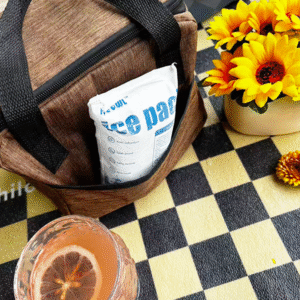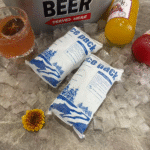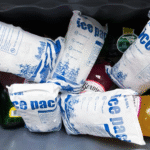Shipping perishables requires precise temperature control. Dry ice for cooler dry ice packs offers a superior cooling solution, maintaining subzero temperatures without melting into water. This guide will walk you through the essentials of using dry ice, ensuring your goods remain cold, fresco, and safe during transportation.

What Are Dry Ice Packs for Coolers?
Dry ice packs are solid blocks of carbon dioxide (Co₂) that provide consistent cooling in shipping containers or coolers. A diferencia del hielo normal, dry ice sublimates directly into CO₂ gas, No dejando líquido atrás. At a temperature of -78.5°C (-109.3°F), dry ice maintains a far colder temperature than ice or gel packs, making it perfect for sensitive items such as vaccines, mariscos, y biológicos.
How Does Dry Ice Work in Coolers?
Dry ice works by releasing cold energy through sublimation. A diferencia del hielo tradicional, que se derrite en el agua, dry ice avoids water damage and maintains a much lower temperature for a longer period. Cuando el hielo seco se sublima, it directly transforms into gas, ensuring that the contents of the cooler remain frozen. This property makes dry ice ideal for long-distance shipping and storing perishable goods, as it provides consistent cold without the mess of melting ice.
Benefits of Using Dry Ice for Cooler Packs:
-
Duración de enfriamiento más larga: El hielo seco dura más que el hielo tradicional, keeping items colder for extended periods, which is ideal for long trips.
-
Sin residuos de agua: Dado que el hielo seco se sublima en gas, there is no risk of water damaging goods or packaging.
-
Efficient Use of Space: Dry ice takes up less space compared to traditional ice, leaving more room for your products.
-
Better for Sensitive Items: Dry ice is essential for goods requiring precise, ultra-low temperatures like vaccines, muestras de biotecnología, or specialty food items such as seafood.
Step-by-Step Guide: How to Use Dry Ice for Cooler Packs
Using dry ice in a cooler is a straightforward process, but it requires specific handling to ensure safety and effectiveness. Here’s how to properly pack and handle dry ice in coolers.
Paso 1: Elija el refrigerador correcto
When selecting a cooler, the most important factors to consider are insulation and ventilation. A high-quality cooler, like those from YETI or Grizzly, helps retain cold air, minimizing sublimation and extending the lifespan of dry ice.
-
Aislamiento: Thick insulation reduces the rate at which dry ice sublimates. A well-insulated cooler ensures your dry ice will last longer and maintain a consistent temperature.
-
Ventilación: El hielo seco se sublima en gas dióxido de carbono, which can build up pressure inside the cooler. Ensure that your cooler has proper ventilation holes to allow gas to escape safely.
Paso 2: Handle Dry Ice Safely
Dry ice is extremely cold and requires careful handling to avoid injury. Always wear insulated gloves or use tongs when handling dry ice to prevent frostbite. Para envíos más grandes, ensure that dry ice is packed securely to avoid any movement that might damage your goods during transit.
Paso 3: Pack the Goods and Dry Ice
Once you’ve prepared your cooler, it’s time to pack the dry ice and goods together. Here’s how to layer your cooler for maximum efficiency:
-
Capa inferior: Place the dry ice at the bottom of the cooler, as cold air naturally sinks.
-
Barrier Layer: Add a layer of newspaper or cardboard above the dry ice to prevent direct contact with the goods. This will help protect sensitive items from the extreme cold.
-
Capa superior: Place your frozen or perishable items above the barrier. Make sure items are tightly packed to minimize air space and prevent temperature fluctuations.
Paso 4: Seal the Cooler
Once the cooler is packed, securely close the lid. Sin embargo, don’t seal it airtight. Carbon dioxide gas needs a way to escape to avoid pressure buildup that could cause the cooler to burst. If your cooler has a drain plug, leave it slightly open for ventilation.
Paso 5: Monitorear la temperatura
Para envíos sensibles, it’s a good practice to monitor the internal temperature during transit. Temperature monitoring devices, such as data loggers or wireless sensors, can provide real-time updates and ensure the temperature stays within the desired range.
Paso 6: Dispose of Dry Ice Safely
Once the dry ice has sublimated, dispose of it safely in a well-ventilated area. Never dispose of dry ice in a sealed container, as the buildup of gas can lead to an explosion.
Best Practices for Using Dry Ice for Coolers
To make the most of dry ice for your shipments, consider the following best practices:
-
Plan for Sublimation: Dry ice sublimates at a rate of about 5-10 libra cada 24 horas. Always calculate how much dry ice you need based on this rate to ensure that it lasts for the required duration.
-
Monitor Temperature Sensitivity: For highly sensitive items, como productos farmacéuticos, it’s essential to maintain the correct temperature. Use temperature sensors or data loggers to ensure that conditions stay within the specified range.
-
Plan for Ventilation: Always ensure that the cooler allows proper gas release. If you’re shipping a large quantity of dry ice, consider using containers specifically designed to handle carbon dioxide.
Hielo seco vs. Gel Packs vs. Hielo regular: Que es mejor?
| Característica | Hielo seco | Paquetes de gel | Hielo regular |
|---|---|---|---|
| Temperatura | -109.3°F (-78.5°C) | Varía, typically 32°F-0°F | 32°F (0°C) |
| Duración del enfriamiento | 12–24 hours or more | 1–3 days depending on type | 1–10 days depending on cooler |
| Residuo | Sublimate al gas, sin liquido | Leaves gel residue | Se derrite en el agua |
| Uso ideal | Artículos congelados, vacunas, mariscos | Enfriamiento a corto plazo | Bebidas, viajes cortos |
Dry ice is ideal for situations that require subzero temperatures and extended cooling, such as transporting frozen meats, mariscos, o productos farmacéuticos. En contraste, gel packs are better for moderate cooling needs, like shipping beverages or perishable items that don’t need freezing temperatures.
Preguntas frecuentes (Preguntas frecuentes)
Q1: How much dry ice do I need for a 25-quart cooler?
A standard guideline is to use 10 a 15 pounds of dry ice per day. For a 25-quart cooler, this should suffice for a 1–2 day trip.
Q2: Can I use dry ice for food shipping?
Sí, dry ice is commonly used for shipping perishable foods, especially those that require sub-zero temperatures, such as seafood or frozen items.
Q3: ¿Cuánto dura el hielo seco en un refrigerador??
Dry ice typically lasts 12–24 hours in an insulated cooler, depending on the amount used and the external temperature.
Q4: Can I dispose of dry ice in a trash can?
No, dry ice must be allowed to sublimate in a well-ventilated area. Never dispose of it in a sealed container or trash can as this can cause an explosion.
Conclusión
Dry ice for cooler dry ice packs is an effective and reliable solution for shipping temperature-sensitive items. Al comprender cómo funciona el hielo seco, how to handle it safely, and how to pack it efficiently, you can ensure your goods remain fresh and safe during transit. Si está enviando comida, productos farmaceuticos, or biotech samples, dry ice provides an unbeatable solution for cold chain logistics.
Para resultados óptimos, plan ahead, calculate your dry ice requirements, and use appropriate containers and safety measures.























